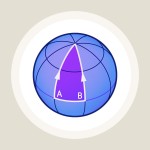Special relativity / Elementary Tour: Conclusion
As this brief tour of special relativity has shown, we have to re-think our notions of space and time in Einstein’s world. Moving clocks tick at a slower rate, light speed is the same for all (inertial) observers, and lengths and distances depend on who measures them – unfamiliar territory, if we go by everyday experience. The main reason that we don’t see those relativistic effects every day is because life around us is moving very, very slowly, compared to the speed of light. Even a jet plane flying at full speed reaches a mere fraction of light speed, less than a thousandth of a percent. Compared to light speed, everyday motions are extremely slow, so the relativistic deviations from our classical notions of space and time are correspondingly small.
Special relativity is more than just another branch of physics. It is a framework into which other physical laws can be embedded: All physical laws in which space and time play a role naturally depend on the properties of space and time, and those are governed by special relativity. Indeed, relativistic generalizations have been found for almost all laws of physics that predate special relativity. For instance, we have relativistic thermodynamics and fluid dynamics. In one case the laws didn’t need any changing at all: The laws of electric and magnetic forces, described by Maxwell’s equations, fit the special-relativistic framework perfectly. (In fact, it was their incompatibility with previous notions of space and time that led Einstein to develop his theory in the first place.) The marriage of special relativity and quantum theory is a success story in a class of its own, and I’ll come back to it later in the chapter on Relativity and the quantum.
There’s one snag however: One of the most important forces of classical mechanics, gravity, doesn’t fit into the new framework at all. This problem led Einstein to a more general theory, which has even more flexible concepts of space and time (and even more spectacular consequences): General relativity, the next item on the agenda of Elementary Einstein.
Next chapter: General relativity
If, on the other hand, you would like to explore special relativity further, you will find more food for thought in the category Special relativity of our Spotlights on relativity, each of which is a brief text addressing one particular aspect of relativistic physics.









